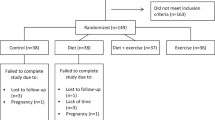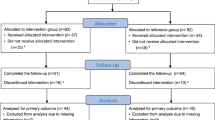Abstract
Exercise-induced asthma (EIA) occurs in up to 90% of individuals with asthma and approximately 10% of the general population without asthma. EIA describes a condition in which vigorous physical activity triggers acute airway narrowing with heightened airway reactivity resulting in reductions in forced expiratory volume in 1 second of greater than 10% compared with pre-exercise values. Treatment of EIA almost exclusively involves the use of pharmacological medications. However, there is accumulating evidence that a dietary excess of salt and omega-6 fatty acids, and a dietary deficiency of antioxidant vitamins and omega-3 fatty acids, can modify the severity of EIA. The modification of these dietary factors has the potential to reduce the incidence and prevalence of this disease. The dietary component most studied to date is dietary salt. Recent studies have supported a role for dietary salt as a modifier of the severity of EIA, suggesting that salt-restrictive diets can reduce the severity of EIA. Since EIA is part of the asthmatic diathesis, it is possible that EIA may serve as a useful model for investigation of potential dietary interventions for reducing airway hyperresponsiveness.




Similar content being viewed by others
Notes
The use of tradenames is for product identification purposes only and does not imply endorsement.
References
Centers for Disease Control and Prevention. Forecasted state-specific estimates for self-reported asthma prevalence — United States. MMWR Morb Mortal Wkly Rep 1998; 4: 12
The International Study of Asthma and Allergies in Childhood (ISAAC) Steering Committee. Worldwide variation in prevalence of symptoms of asthma, allergic rhinoconjunctivitis, and atopic eczema: ISAAC. Lancet 1998; 351(9111): 1225–32
Australian Bureau of Statistics. National health survey: asthma and other respiratory conditions [report no. 4373.0]. Canberra: Australian Bureau of Statistics, 1998
Lacroix VJ. Exercise-induced asthma. Phys Sportsmed 1999; 27(12): 75–92
Rupp NT. Diagnosis and management of exercise-induced asthma. Phys Sportsmed 1996; 24: 77–86
Voy RO. The US Olympic Committee experience with exercise-induced bronchospasm, 1984. Med Sci Sports Exerc 1986; 18(3): 328–30
Wilber RL, Rundell KW, Szmedra L, et al. Incidence of exercise-induced bronchospasm in Olympic winter sport athletes. Med Sci Sports Exerc 2000; 32(4): 732–7
Haby MM, Peat JK, Mellis CM, et al. An exercise challenge for epidemiological studies of childhood asthma: validity and repeatability. Eur Respir J 1995; 8(5): 729–36
Stoesser A, Cook M. Possible relation between electrolyte balance and bronchial asthma. Am J Dis Child 1938; 56: 943–4
Burney P. A diet rich in sodium may potentiate asthma: epidemiologic evidence for a new hypothesis. Chest 1987; 91 (6 Suppl.): 143S–8S
Burney PG. The causes of asthma: does salt potentiate bronchial activity? J R Soc Med 1987; 80(6): 364–7
Burney PG, Britton JR, Chinn S, et al. Descriptive epidemiology of bronchial reactivity in an adult population: results from a community study. Thorax 1987; 42(1): 38–44
Burney PGJ, Britton JR, Chinn S, et al. Response to inhaled histamine and 24 hour sodium excretion. BMJ 1986; 292: 1483–6
Burney PG, Neild JE, Twort CH, et al. Effect of changing dietary sodium on the airway response to histamine. Thorax 1989; 44(1): 36–41
Carey OJ, Locke C, Cookson JB. Effect of alterations of dietary sodium on the severity of asthma in men. Thorax 1993; 48(7): 714–8
Javaid A, Cushley MJ, Bone MF. Effect of dietary salt on bronchial reactivity to histamine in asthma. BMJ 1988; 297(6646): 454
Tribe RM, Barton JR, Poston L, et al. Dietary sodium intake, airway responsiveness, and cellular sodium transport. Am J Respir Crit Care Med 1994; 149(6): 1426–33
Lieberman D, Heimer D. Effect of dietary sodium on the severity of bronchial asthma. Thorax 1992; 47(5): 360–2
Mickleborough TD, Cordain L, Gotshall RW, et al. A low sodium diet improves indices of pulmonary function in exercise-induced asthma. J Exerc Physiol 2000; 3(2): 46–54
Mickleborough TD, Gotshall RW, Cordain L, et al. Dietary salt alters pulmonary function during exercise in exercise-induced asthmatics. J Sports Sci 2001; 19(11): 865–73
Gotshall RW, Mickleborough TD, Cordain L. Dietary salt restriction improves pulmonary function in exercise-induced asthma. Med Sci Sports Exerc 2000; 32(11): 1815–9
Kurtz TW, Al-Bander HA, Morris Jr RC. ‘Salt-sensitive’ essential hypertension in men: is the sodium ion alone important? N Engl J Med 1987; 317(17): 1043–8
Shore AC, Markandu ND, MacGregor GA. A randomized crossover study to compare the blood pressure response to sodium loading with and without chloride in patients with essential hypertension [published erratum appears in J Hypertens 1988 Nov; 6 (11): i]. J Hypertens 1988; 6(8): 613–7
Kurtz TW, Morris RC. Dietary chloride and bicarbonate as determinants of desoxycortocosterone hypertension. J Hypertens 1984; 2: 371–3
Medici TC, Schmid AZ, Hacki M, et al. Are asthmatics salt-sensitive? A preliminary controlled study. Chest 1993; 104(4): 1138–43
Mickleborough TD, Gotshall RW, Kluka EM, et al. Dietary chloride as a possible determinant of the severity of exercise-induced asthma. Eur J Appl Physiol 2001; 85(5): 450–6
Gotshall RW, Fedorczak LJ, Rasmussen JJ. One week versus two weeks of a low salt diet and severity of exercise-induced bronchoconstriction [abstract]. Med Sci Sports Exerc 2003; 35(5): S10
Mickleborough TD, Gotshall RW, Rhodes J, et al. Elevating dietary salt exacerbates hyperpnea-induced airway obstruction in guinea pigs. J Appl Physiol 2001; 91(3): 1061–6
Festing MHW. Genetics. In: Wagner JE, Manning PJ, editors. The biology of the guinea pig. New York: Academic Press Inc., 1976: 99–135
Council NR. Water and electrolytes: recommended dietary allowances. 10th ed. Washington, DC: National Academy Press, 1989: 247–61
Krauss RM, Eckel RH, Howard B, et al. AHA Dietary Guidelines, revision 2000: a statement for healthcare professionals from the Nutrition Committee of the American Heart Association. Circulation 2000; 102(18): 2284–99
Lee TH, Hoover RL, Williams JD, et al. Effect of dietary enrichment with eicosapentaenoic and docosahexaenoic acids on in vitro neutrophil and monocyte leukotriene generation and neutrophil function. N Engl J Med 1985; 312(19): 1217–24
Endres S, Ghorbani R, Kelley VE, et al. The effect of dietary supplementation with n-3 polyunsaturated fatty acids on the synthesis of interleukin-1 and tumor necrosis factor by mononuclear cells. N Engl J Med 1989; 320(5): 265–71
Kromann N, Green A. Epidemiological studies in the Upernavik district, Greenland: incidence of some chronic diseases 1950–1974. Acta Med Scand 1980; 208(5): 401–6
Payan DG, Wong MY, Chernov-Rogan T, et al. Alterations in human leukocyte function induced by ingestion of eicosapentaenoic acid. J Clin Immunol 1986; 6(5): 402–10
Arm JP, Horton CE, Spur BW, et al. The effects of dietary supplementation with fish oil lipids on the airways response to inhaled allergen in bronchial asthma. Am Rev Respir Dis 1989; 139(6): 1395–400
Arm JP, Horton CE, Mencia-Huerta JM, et al. Effect of dietary supplementation with fish oil lipids on mild asthma. Thorax 1988; 43(2): 84–92
Hodge L, Salome CM, Hughes JM, et al. Effect of dietary intake of omega-3 and omega-6 fatty acids on severity of asthma in children. Eur Respir J 1998; 11(2): 361–5
Thien FC, Mencia-Huerta JM, Lee TH. Dietary fish oil effects on seasonal hay fever and asthma in pollen-sensitive subjects. Am Rev Respir Dis 1993; 147(5): 1138–43
Kirsch CM, Payan DG, Wong MY, et al. Effect of eicosapentaenoic acid in asthma. Clin Allergy 1988; 18(2): 177–87
Nagakura T, Matsuda S, Shichijyo K, et al. Dietary supplementation with fish oil rich in omega-3 polyunsaturated fatty acids in children with bronchial asthma. Eur Respir J 2000; 16(5): 861–5
Broughton KS, Johnson CS, Bobin KP, et al. Reduced asthma symptoms with n-3 fatty acid ingestion are related to 5-series leukotriene production. Am J Clin Nutr 1997; 65: 1011–117
Okamoto M, Mitsunobu F, Ashida K, et al. Effects of dietary supplementation with n-3 fatty acids compared with n-6 fatty acids on bronchial asthma. Intern Med 2000; 39(2): 107–11
Dry J, Vincent D. Effect of a fish oil diet on asthma: results of a 1-year double-blind study. Int Arch Allergy Appl Immunol 1991; 95(2–3): 156–7
Masuev KA. The effect of polyunsaturated fatty acids of the omega-3 class on the late phase of the allergic reaction in bronchial asthma patients. Ter Arkh 1997; 69(3): 31–3
Masuev KA. The effect of polyunsaturated fatty acids on the biochemical indices of bronchial asthma patients. Ter Arkh 1997; 69(3): 33–5
Villani F, Comazzi R, De Maria P, et al. Effect of dietary supplementation with polyunsaturated fatty acids on bronchial hyperreactivity in subjects with seasonal asthma. Respiration 1998; 65(4): 265–9
Picado C, Castillo JA, Schinca N, et al. Effects of a fish oil enriched diet on aspirin intolerant asthmatic patients: a pilot study. Thorax 1988; 43(2): 93–7
Mickleborough TD, Murray RL, Lindley MR. Elevating dietary omega-fatty acid consumption reduces the severity of exercise-induced bronchoconstriction [abstract]. Med Sci Sports Exerc 2003; 35(5): S10
Hatch GE. Asthma, inhaled oxidants, and dietary antioxidants. Am J Clin Nutr 1995; 61 (3 Suppl.): 625S–30S
Kaur B, Rowe BH, Ram FS. Vitamin C supplementation for asthma. Available in The Cochrane Library [database on disk and CD ROM]. Updated quarterly. The Cochrane Collaboration; issue 4. Oxford: Update Software, 2001: CD000993
Schachter EN, Schlesinger A. The attenuation of exercise-induced bronchospasm by ascorbic acid. Ann Allergy 1982; 49(3): 146–51
Cohen HA, Neuman I, Nahum H. Blocking effect of vitamin C in exercise-induced asthma. Arch Pediatr Adolesc Med 1997; 151(4): 367–70
Miric M, Haxihu MA. Effect of vitamin C on exercise-induced bronchoconstriction. Plucne Bolesti 1991; 43(1–2): 94–7
Neuman I, Nahum H, Ben-Amotz A. Prevention of exercise-induced asthma by a natural isomer mixture of beta-carotene. Ann Allergy Asthma Immunol 1999; 82(6): 549–53
Neuman I, Nahum H, Ben-Amotz A. Reduction of exercise-induced asthma oxidative stress by lycopene, a natural antioxidant. Allergy 2000; 55(12): 1184–9
Murphy JD, Ferguson CS, Brown KR, et al. The effect of dietary antioxidants on lung function in exercise-induced asthmatics [abstract]. Med Sci Sports Exerc 2002; 34(5): S155
Hartert TV, Peebles RS. Dietary antioxidants and adult asthma. Curr Opin Allergy Clin Immunol 2001; 1(5): 421–9
Centanni S, Santus P, Di Marco F, et al. The potential role of tocopherol in asthma and allergies: modification of the leukotriene pathway. Biodrugs 2001; 15(2): 81–6
Henricks PA, Nijkamp FP. Reactive oxygen species as mediators in asthma. Pulm Pharmacol Ther 2001; 14(6): 409–20
Bukowskyj M, Nakatsu K. The bronchodilator effect of caffeine in adult asthmatics. Am Rev Respir Dis 1987; 135(1): 173–5
Curatolo PW, Robertson D. The health consequences of caffeine. Ann Intern Med 1983; 98 (5 Pt 1): 641–53
Bara AI, Barley EA. Caffeine for asthma. Available in The Cochrane Library [database on disk and CD ROM]. Updated quarterly. The Cochrane Collaboration; issue 4. Oxford: Update Software, 2001: CD001112
Kivity S, Ben Aharon Y, Man A, et al. The effect of caffeine on exercise-induced bronchoconstriction. Chest 1990; 97(5): 1083–5
Duffy P, Phillips YY. Caffeine consumption decreases the response to bronchoprovocation challenge with dry gas hyperventilation. Chest 1991; 99(6): 1374–7
Smit HA, Grievink L, Tabak C. Dietary influences on chronic obstructive lung disease and asthma: a review of the epidemiological evidence. Proc Nutr Soc 1999; 58(2): 309–19
Baker JC, Ayres JG. Diet and asthma. Respir Med 2000; 94(10): 925–34
Gotshall RW. Exercise-induced bronchoconstriction. Drugs 2002; 62(12): 1725–39
Acknowledgements
Partial support for the dietary salt studies was provided by the US Olympic Committee and US Swimming, the PADI Foundation and the College Research Council, College of Veterinary Medicine and Biomedical Sciences, Colorado State University, CO, USA. The authors have no conflict of interest with regard to the information provided in this review.
Author information
Authors and Affiliations
Corresponding author
Rights and permissions
About this article
Cite this article
Mickleborough, T.D., Gotshall, R.W. Dietary Components with Demonstrated Effectiveness in Decreasing the Severity of Exercise-Induced Asthma. Sports Med 33, 671–681 (2003). https://doi.org/10.2165/00007256-200333090-00003
Published:
Issue Date:
DOI: https://doi.org/10.2165/00007256-200333090-00003




